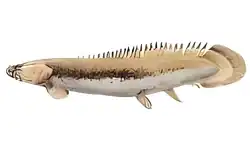Cladistia
Cladistia is a clade of bony fishes whose only living members are the bichirs.[1] Their major synapomorphies are a heterocercal tail in which the dorsal fin has independent rays, and a posteriorly elongated parasphenoid.
| Cladistia Temporal range: (Possible Carboniferous record, molecular evidence supports Devonian origin) | |
|---|---|
 | |
| Polypterus senegalus | |
| Scientific classification | |
| Domain: | Eukaryota |
| Kingdom: | Animalia |
| Phylum: | Chordata |
| Class: | Actinopterygii |
| Subclass: | Cladistia Pander 1860 emend. Cope 1871 sensu Lund 2000 |
| Orders | |
| |
Cladistia are the earliest diverging branch of living Actinopterygii, sister group of Actinopteri, the group which includes all other living ray finned fish.
Aside from bichirs, other extinct fish groups thought to be members of the group include the Scanilepiformes, known from the Triassic period.[2]
Taxonomy
Based on work done by Lund 2000 [3]
- Order †Guildayichthyiformes Lund 2000
- Family †Guildayichthyidae Lund 2000
- Genus †Guildayichthys Lund 2000
- Species †Guildayichthys carnegiei Lund 2000
- Genus †Discoserra Lund 2000
- Species †Discoserra pectinodon Lund 2000
- Genus †Guildayichthys Lund 2000
- Family †Guildayichthyidae Lund 2000
- Order Polypteriformes Bleeker 1859
- Genus †Latinopollia Meunier and Gayet 1998
- Species †Latinopollia suarezi (Meunier & Gayet 1996) Meunier & Gayet 1998
- Genus †Dagetella Gayet & Meunier 1991
- Species †Dagetella sudamericana Gayet & Meunier 1991
- Genus †Bartschichthys Gayet & Meunier 1996 [Bartschia Gayet & Meunier 1996 non Rehder 1943]
- Species †B. arnoulti (Gayet & Meunier 1996) [Bartschia arnoulti Gayet & Meunier 1996]
- Species †B. napatensis Werner & Gayet 1997
- Species †B. tubularis (Gayet & Meunier 1996) [Bartschia tubularis Gayet & Meunier 1996]
- Genus †Sudania Werner & Gayet 1997
- Species †S. gracilis Werner & Gayet 1997
- Species †S. oblonga Werner & Gayet 1997
- Genus †Saharichthys Werner & Gayet 1997
- Species †S. nigeriensis (Gayet & Meunier 1996) [Sainthilairia nigeriensis Gayet & Meunier 1996]
- Species †S. africanus (Gayet & Meunier 1996) [Sainthilairia africana Gayet & Meunier 1996]
- Genus †Sainthilairia Gayet & Meunier 1996
- Species †S. beccussiformis Gayet & Meunier 1996
- Species †S. elongata Werner & Gayet 1997
- Species †S. falciformis Gayet & Meunier 1996
- Species †S. grandis Gayet & Meunier 1996
- Species †S. intermedia Werner & Gayet 1997
- Genus †Inbecetemia Werner & Gayet 1997
- Species †I. torta (Gayet & Meunier 1996) [Sainthilairia torta Gayet & Meunier 1996]
- Species †I. tortissima (Gayet & Meunier 1996) [Sainthilairia tortissima Gayet & Meunier 1996]
- Genus †Nagaia Werner & Gayet 1997
- Species †Nagaia extrema Werner & Gayet 1997
- Family Polypteridae Lacépède 1803 sensu stricto
- Genus †Bawitius Grandstaff et al. 2012
- Species †Bawitius bartheli (Schaal 1984) Grandstaff et al. 2012 [Polypterus bartheli Schaal 1984]
- Genus †Serenoichthys Dutheil 1999
- Species †Serenoichthys kemkemensis Dutheil 1999
- Genus Erpetoichthys Smith 1865 [Calamoichthys Smith 1866]
- Species Erpetoichthys calabaricus
- Genus Polypterus Lacepède 1803
- Species Polypterus ansorgii Boulenger, 1910
- Species Polypterus bichir Lacépède, 1803
- Species Polypterus congicus Boulenger, 1898
- Species Polypterus delhezi Boulenger, 1899
- Species Polypterus endlicheri Heckel, 1847
- Species Polypterus mokelembembe Schliewen & Schäfer, 2006
- Species Polypterus ornatipinnis Boulenger, 1902
- Species Polypterus palmas Ayres, 1850
- Species Polypterus polli J. P. Gosse, 1988
- Species Polypterus retropinnis Vaillant, 1899
- Species Polypterus senegalus Cuvier, 1829
- Species Polypterus teugelsi Britz, 2004
- Species Polypterus weeksii Boulenger, 1898
- Genus †Bawitius Grandstaff et al. 2012
- Genus †Latinopollia Meunier and Gayet 1998
References
- Lecointre G, Le Guyader H (2007). The Tree of Life: A Phylogenetic Classification. Harvard University Press Reference Library. ISBN 978-0-674-02183-9.
- Argyriou T, Giles S, Friedman M, Romano C, Kogan I, Sánchez-Villagra MR (November 2018). "Internal cranial anatomy of Early Triassic species of †Saurichthys (Actinopterygii: †Saurichthyiformes): implications for the phylogenetic placement of †saurichthyiforms". BMC Evolutionary Biology. 18 (1): 161. doi:10.1186/s12862-018-1264-4. PMC 6211452. PMID 30382811.
- Mikko Haaramo. "Cladistia – bichirs and relatives". Mikko's Phylogeny Archive. Retrieved 2013-10-26.
This article is issued from Wikipedia. The text is licensed under Creative Commons - Attribution - Sharealike. Additional terms may apply for the media files.

